Eastern Volunteers
|
Introduction
Because of all the different nationalities that used to form the Soviet Union, the term
Russian or Soviet is use interchangeable and loosely. For simplification purposes it will
be use unless otherwise mentioned.
During the German invasion, thousands of Soviet soldiers were surrendering or deserting
their post. By August 1941, there were closed to half a million Soviet prisoners of war.
Because of the sheer quantity of prisoners taken, the Germans had placed them in temporary
internment camps.
The internment camps were unsafe since hundreds of thousands of Soviets
prisoners were dying from starvation and decease. Many of the Russian prisoners volunteered
for German military service. The Germans took this needed manpower, since casualties were
amounting on the Eastern Front. The German Army used these volunteers as auxiliaries called
"Hilfsfreiwillige."
The Russian prisoners who volunteered were used for such duties as laborers,
cooks, interpreters, guards, etc.
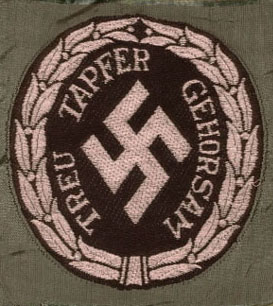 When the Germans occupied the Ukrainian and Baltic States
they were cheered and hailed as liberators. The Germans drafted volunteers from these countries to form
"Schuma"
Battalions for police duties.
When the Germans occupied the Ukrainian and Baltic States
they were cheered and hailed as liberators. The Germans drafted volunteers from these countries to form
"Schuma"
Battalions for police duties.
These "Schuma" battalions were divided into sub-groups:
(1) "Wacht" (Guard)
(2) "Ersatz" (Replacement)
(3) "Bau" (Construction)
(4) "Front" (Front line combat) battalions
All these formations wore the distinctive "Schuma" sleeve shield. The emblem is an
elongated swastika surrounded by the German words "Treu, Tapfer, Gehorsham" (Loyal, Brave and
Steadfast) within an oval wreath of laurel leaves.
By April 1943, each "Schuma" sub-group was
introduced with wearing color coded arm shields to distinguish the different duties, which were as follows:
Schutpolizei Light Green
Gendarmerie Orange
Fire Brigade Units Crimson
On top is SCHUMA Officer shield weave in silver aluminum thread on black field background.
The enlisted is threaded silver-grey cotton.
By 1943, these volunteers served with combat units for the Waffen-SS.
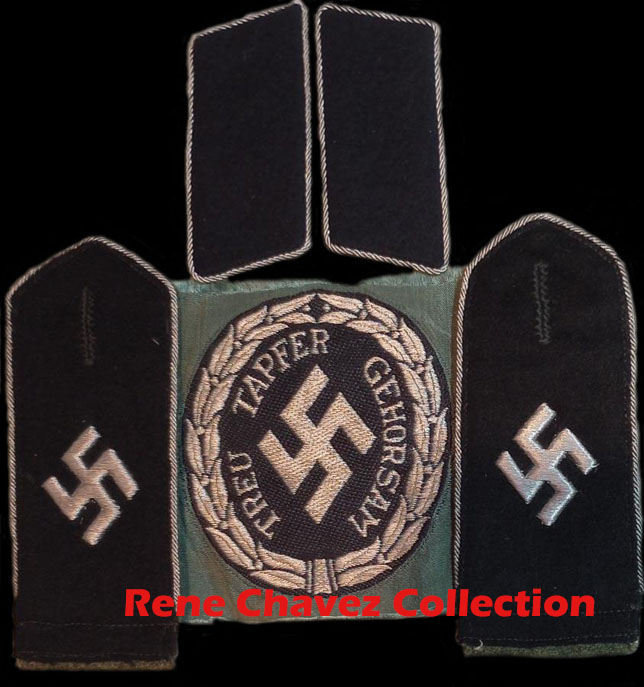
Above is a scarce SCHUMA officer insignia set; On top two black blank collar tabs with silver wire piping; Below on the sides a pair of SCHUMA officer boards in the center shows silver wire machine embroidered swastikas and silver wire piping on the edges; In the center shows a SCHUMA officer shield.
|
|
Turkistan & Eastern SS Insignia
The Germans formed "Ost" (Eastern) Battalions from recruited
prisoners of war and deserters. These Ost Battalions were fitted among the German Regiments and
Divisions. The volunteers from the Ost Battalions were used as rear-area police duties.
Most of these Legions were used to fight anti-partisan operations in Russia and later in Yugoslavia.
One of the most distinguishing combat formations were members of the Turkistan Legion.
The Legion was formed in the spring of 1942 as part of the
German 162nd Infantry Division,
referred as the "Turkoman Division." It saw extensive action in Yugoslavia and
Italy.
In November 1943, the "Ostmanische SS-Division" was formed comprising of three separate eastern groups:
Turkistan, Idel-ural and Crimea.
Reichsführer Himmler was very interested in this Eastern SS formation
because his intent was to utilize some of the cadre personal for a training unit with the hope of raising
further Eastern volunteer units. Because of volunteer shortages the unit was later designated as
"1. Ostmusselmanisches SS-Regiment" in July 1944.
Finaly by October 1944, with more volunteers and
conscriptions it was re-named as the
"Osttürkischer Waffen-Verband der SS.
By March 1945 the Azerbaijan legion was added.
Below is a sample of insignias worn by members of the Turkistan Legion and Waffen-SS.

On
top
is a Wolf's Head collar tab with enlisted
rank. It was intended to be worn by Crimean Tartar and Volga Tartar
volunteers, one of four formations to be used in the creation
of the
"30. Waffen-Grenadier Division der SS (Westruthenische
Nr. 1)."
Another
interesting insignia is the German made cuffband with
the green color, which represented the ethnic muslims.
The BeVo woven cuffband is made of bright green rayon with white
Latin script "Osttürkischer Waffen-Verband der SS." The cuffband
is border at both top and bottom edges in vertically woven white
thread. The reverse shows the typical salt & pepper patterned
found on these BeVo style bands.
Below on your left
is a very rare early first pattern Turkistan
shield. Oval grey-green backing with a light-grey border; depicting
a white mosque with a center coupola in white and blue, two side
spires and a large entry gate, all outlined in yellow with light
blue shadows. Below the mosque is the inscription "TURKISTAN"
and arched above the inscription "BIZ ALLA BILEN." (God with us)
The Germans appear to have believed that "Biz Alla Bilen" was the
Arabic equivalent of "Got mit uns" (God with us), which was the German Army
motto.
NOTE:
Correctly this should have been "Allah biz bilen. There may have
been some objection to this both as a grammatical error and to the fact that
although five languages "Kazakh, Kirgiz, Turkmen, Uzbeck and Tajik" are spoken
in the Turkistan region of what was formerly the USSR, Arabic is not one of them!
On your right
is the second pattern shield, issued in September
1943. The angular shape shield has a red and blue horizontal stripes
bordered in black with a black field at the top with the inscription
"TURKISTAN" in light blue. In the center of the shield is the
Legion's emblem a white bow and arrow.
Above
is the gold Eastern Peoples first class with swords
badge that was awarded for bravery. If you want to find out more
information please visit my Eastern People's Awards web page.
|
|
Eastern Legion Volunteers
By November 1941, Legions were created from Asiatic and Caucasians in southern Russia.
These Legionnaires were from Armenia, Azerbaijan, North Caucasus, Turkestan and the Volga Tartar.
Again many of the volunteers saw the Germans as liberators of their homeland. The Legionnaires
were trained in Poland and Germany.
Because of the high combat casualties that the Waffen-SS had
suffered in the Eastern Front, these Eastern troops were transferred to the Waffen-SS by 1944-45.
These Legionnaires wore either German or Russian uniforms.
Most of the Legionnaires were transferred to occupational duties on
the Western Front in such places as the Channel Islands and France. These Legionnaires were disappointed
and dismayed because they wanted to fight the communist. Many of them deserted their post, eventually
the Germans transferred Legionnaires to the Eastern Front.
They all had different national arm shields on their uniforms as shown in the examples below:
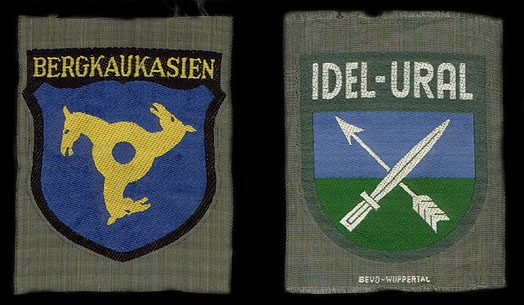
In December 1941, the Caucasian Moslem Legion was formed. By early 1942, the legion was divided into
two groups: the Azerbaidjan and North Caucasian.
The arm shield on your left is a 2nd pattern 1943 insignia worn by North Caucasians.
The shield has an interesting emblem of three horse heads joined to a central circular base
in yellow on a blue background. The top black border has the inscription "BERGKAUKASIEN" (Caucasius
Mountains).
These Caucasien troops were stationed in northern France during the winter
of 1943.
The other shield was issued in 1942 and worn by Volga Tartar volunteers. This arm shield shows a
white crossed knife and arrow on a blue and green horizontal stripe background. The black border on top
has the white inscription "IDEL-URAL." The word "IDEL" in Tartar means Volga River.
|
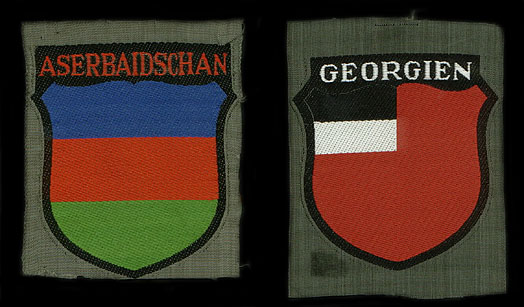
The arm shield shown above is a 1st pattern 1942 Azerbaidjani arm shield with the horizontal
blue/red/green national colors surmounted by the word "ASERBAIDSCHAN" in red.
Next is the Georgian Legion arm shield in dull red with a black and white horizontal stripe in the
upper left quadrant. At the top is the word "GEORGIAN" in white.
|
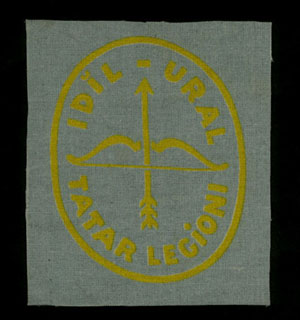
Volga Tartar Shield
Last issued 3rd pattern printed "Idi Ural Tartar Legioni" Shield. Light blue oval with golden-yellow border
and bow and arrow. Elements from this legion were used to form the "Osttürkischer Waffenverband des SS."
|

Eastern Volunteers Shields
On top you'll see four different Eastern Volunteer printed shields. The shield on your left
is a second pattern Turkistan shield worn by troops in the German 162nd Infantry Division.
Next to it is a printed shield worn by Georgian volunteers. This pattern shield was the only
style made. Below is one of the rare printed shields worn by Crimean Tartar volunteers.
There exist another pattern on red background. Next to it is a second pattern shield worn by
Azerbaijan troops in 1943. The first pattern does not have the crescent moon and star.
|
|
Russian Volunteers
One of the first Russian volunteer formations was the Russian National Army of Liberation known as "RONA."
Organized in the winter of 1941-42 under the command of a Russian Captain named Kaminski. This force, which
never exceeded a division fought mainly anti-Partisans in the Bryansk region and later sent to the front lines.
In the summer 1944, it was organized under the Waffen-SS as a brigade. This SS-Brigade, which was referred as
Kaminski's Brigade
obtained a gruesome fame in the Warsaw uprising. After the battle Kaminski was shot by order of Himmler and the remnants of his brigade sent to the Vlasov Army.
Eastern Peoples Shields
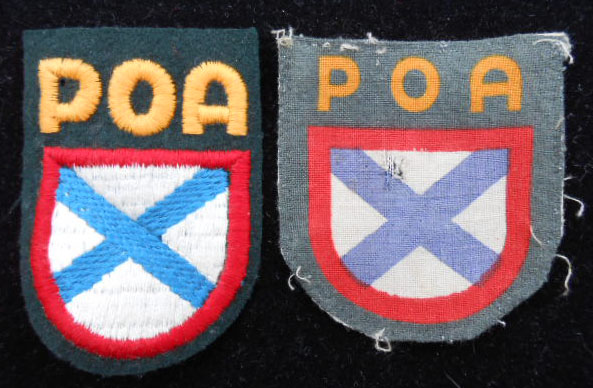
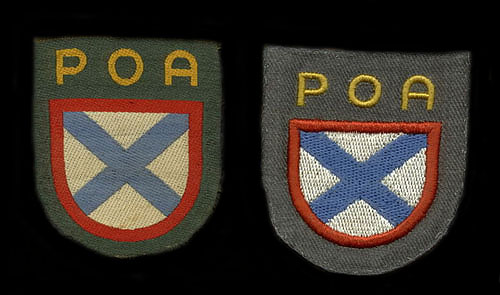
On top you'll see four different pattern Russian volunteer shields. The first two shields shown on
top shows a rare first pattern embroidered POA shield followed by the common fourth pattern
printed shield in used condition. The next two shields below is the German made second pattern
weave type so-called BeVo style while the other is an uncommon third pattern embroidered shield.
In Germany a former distinguished Russian General who was captured convinced his German captors that he could
obtained enough loyal volunteers to fight against the Stalin regime. His name was
General Andrei Andreevich Vlasov.
Early in 1943, with German approval Vlasov formed a national committee and created the "Russkaia Osvoditelnaia Armiia (ROA)"
(Russian Liberation Army). However there were problems with the organization from the start, since half of
the eastern volunteers were opposed of joining Vlasov's Army. Most of them wouldn't consider themselves Russians and
wanted their respective countries liberated from Russian rule.
In September 1944, Himmler met with General Vlassov,
which resulted to the creation of a new committee, called
"Komitet Osvobozhdyeniya Narodov Rossii, (KONR)"
(Committee for the Liberation of the People's of Russia). This Committee and Vlassov's Army were to embrace all Soviet
citizens living under German jurisdiction. Himmler promised to help with the formation of the KONR Army. Because of
the majority of R.O.A. Troops were engaged in different fronts, their transfer to the KONR Army was to take place gradually.
Unfortunately once again, uniting all these different nationalities into KONR formation cause problems to the Germans.
Eventually various eastern national groups agreed to joined Valssovs KONR Army.
In November 1944, the first KONR Division
was organized in the Troop Training Grounds in Muensingen. In mid-February 1945, operational readiness was established
and the KONR Division was designated as the
"600. Infanterie-Division (Russ.)"
under the Command of General Sergei Kuzmich
Bunyachenko. The nucleus of the division consisted of remnants of the 30th SS Russian Infantry Division, which was never
completed, and remnants of the Kaminski Brigade.
The 600th Infantry Division was greatly under strength with acute
shortages of weapons, equipment and supplies, nevertheless it reach the front lines on the Oder in March 1945.
In January 1945, a 2nd KONR Division under the command of General Zveryev was organized and designated as the "650. Infanterie-Division (Russ.)."
Unfortunately it never reached its operational readiness because of shortages in arms and supplies. In April
1945, another Russian formation referred as "Russische Brigade 599"
was organized and located in Viborg, Denmark. The 1st
KONR Division was given the task of capturing the Soviet stronghold in the area of Frankfurt-on-Oder. The offensive attack
committed by the troops of the 1st KONR Division failed, with heavy losses owing to the lack of adequate artillery and air
power. After the failure of this attack, the 1st KONR Division was withdrawn and began the march towards the Czech frontier.
By the end of the war all major Russian, Cossack and Eastern Volunteer formations had attempted to surrender to Western allies.
However practically all the major units were handed back to the Soviets by the Western Allies. There were only two major
Russian formations that were not turned over to the Soviets. The Russian Defense Corps in Serbia, formed from White Russian
exiles and the Ukrainians. The White Russians had taken refuge in Serbia in 1921, and were considered Yugoslav citizens.
The Ukrainians from the 1st Division were placed in POW Camps in Rimini, Italy. They were able to argue from their British
captors that they were Polish citizens.
It should be noted that the Germans conscripted between 2 to 4 million forced laborers from the former Soviet territories to
work in the Third Reich. These labors were called "Ostarbeiters" (Eastern workers). By 1944, there were six million people
deported from the Soviet Union.
|
|
Ukrainian Volunteers
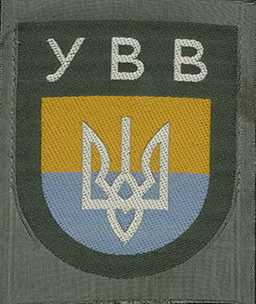
Arm shield of the
U.V.V. "Ukrainske Vyzvolne Viysko"
(Ukrainian Liberation Army). The arm shield has the national colors with the Trident
symbol place in the center. Above the shield is the cyrillic letters resembling Y.B.B., which represents U.V.V.
In 1943, the Germans created a Ukrainian equivalent to the Russian
"R.O.A." Liberation Army. Most of the Ukrainian troops were scattered
throughout a multitude of German units along the front. These troops either wore German uniforms or a combination of other foreign uniforms.
The arm shield was place on the left sleeve of their uniform.
|
[ Front
Page] [Top ][Previous
Page]
|









